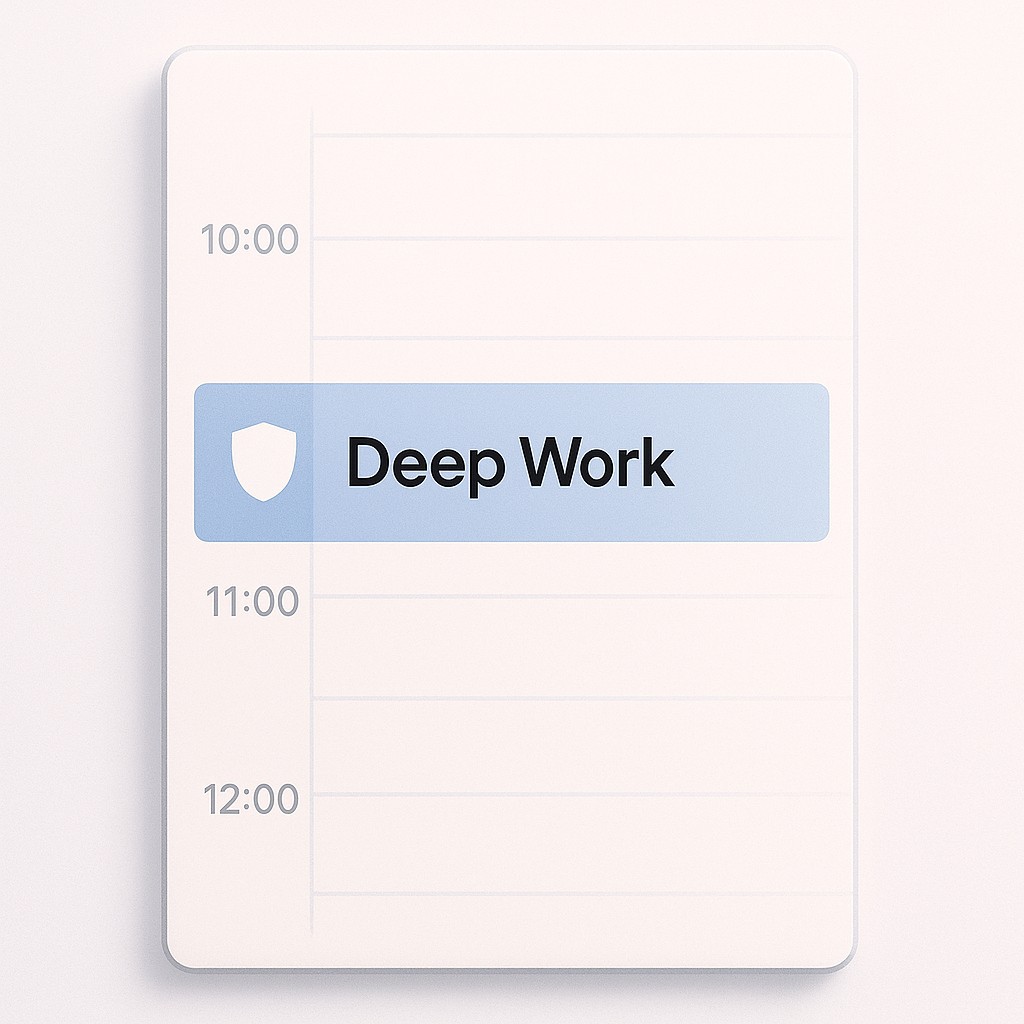Schedule Short Deep Work Sessions for Real Focus and Energy
Schedule Short Deep Work Sessions for Real Focus and Energy

When Meetings Eat Your Workday
Ever finish a week of back-to-back meetings and wonder: is your workday running you, or are you running it?
That question landed especially hard for me after reading Mike’s post last Friday. He’d written about ways to salvage productivity from chaotic schedules, but #3—schedule short deep work sessions—really stood out to me. That insight hit home. My calendar looked like a row of dominoes, and my brain felt about the same by Wednesday.
So here’s what I tried. I blocked a single one-hour slot just for deep work, batched every meeting possible into one afternoon stretch, and killed notifications for that time. Even one protected hour changed the whole day—it just felt less frantic, and I actually got further on the hard stuff than I had all week.
Most of us can only manage 4-5 hours of deep work per day, especially when split into hour-long sessions that maximize energy and focus fs.blog.
Fragmented attention is the real villain here. I’ve experienced how hard it can be to maintain balance in a meeting-heavy world. Stress builds, burnout creeps in, and the more we try to push through with longer hours, the less we actually get done. Even when work gets interrupted, we spend an average of 23 minutes each time getting back into it—and most task hopping adds up fast across a day.
The Mechanics of Focus (And Why Fragmented Days Burn Us Out)
Here’s a hard truth I kept dodging for years. Productivity isn’t measured by how many hours you log—it’s about the intensity you can muster during focused blocks. Think of your brain like a CPU with a limited cache. When you’re practicing deep work for engineers—deep into code, untangled and uninterrupted—you’re running hot—everything you need is right there in memory. But stack too many meetings, jump between tasks, and you start thrashing. Context lost, progress stalling, just burning cycles to reload the basics again and again.
The real cost of constant interrupts and meeting fragmentation isn’t always obvious at first. Every switch—Slack ping, calendar alert, someone knocking on your door—comes with a hidden tax. You spend precious mental energy just rebuilding context, and that overhead only gets worse as the day goes on. I used to think adding hours would make up the difference. But what really happens? You finish later, yes, but you’re drained, and your actual output flatlines. Burnout doesn’t come from working hard. It comes from always working scattered. I’ve caught myself staring at the same line of code after too many back-to-back calls, wondering why my brain felt fried.
That’s why batching meetings is such a game changer. When you use deep work time blocking by scheduling meetings into the afternoon—while keeping the morning free for deep work and planning—you carve out longer stretches to actually build momentum calnewport.com. It’s the difference between stringing together random 30-minute gaps and having a real shot at finishing something meaningful in one go.
Protecting your deep work sprints isn’t just about finding open slots. It’s about guarding that time on all sides. Set status messages so colleagues know when you’re heads-down. Turn off emails, chats, and notifications. Be clear about when you’re available—boundaries make it easier for everyone. The first few weeks are awkward, but after a while you wish you’d started sooner.
A quick callback to earlier: that “dominoes” setup I mentioned—it taught me how easy it is to lose whole days to context switching. Now I actually look for ways to chain deep work blocks together, even if it means wrestling my calendar every Sunday.
If there’s one thing I wish I’d understood earlier, it’s this. Bursts of focused intensity beat extra hours every time, especially when interruptions keep piling up. The goal isn’t perfection—it’s a rhythm that lets you do your best work with energy left at the end of the day.
How to Schedule Short Deep Work Sessions for Real Focus
Start simple. Actually schedule short deep work sessions—block out a single hour on your calendar at the same time every day, if you can swing it. Mark it as “Do Not Disturb,” add a little lock emoji if you want, and treat it as non-negotiable. You’ll be surprised how much easier it is to focus when you’ve already decided not to wing it.

Meetings are unavoidable, but you do control the pattern. Try to batch shallow work by bunching them together into a meeting train. Instead of scattering short calls all over your schedule, create a block—maybe after lunch—where you get through them in one go. Yes, it’s draining to stack them, but you reclaim a chunk of time wide enough for real progress. This move turns those awkward 30-minute dead zones into genuine focus time. Honestly, it reminds me of batch-cooking on Sunday nights, and the same logic applies: less mental clean-up, more time at full throttle.
For routine updates—the kind where everyone just wants to know what moved and what’s stuck—switch things to async. Drop notes in a shared doc or record a short video update when typing feels like too much. Collaboration doesn’t have to happen live every single time, and freeing up that calendar space is a big win.
Quick messy tangent: Last month, I tried to save time by eating lunch at my desk for a week straight. By Thursday, not only did my keyboard have mysterious crumbs lodged under the keys, but I found myself thinking about the morning’s meetings while trying to debug something hours later. Now I make myself step away—sometimes it’s just for a walk around the block, sometimes actually doing a couple of push-ups (still awkwardly, to be honest), but I swear it presses reset on my brain better than any productivity app does.
During your deep work sprints—protect focus time like you mean it. No emails, no Slack, no pings except for true emergencies. Set your status, make your response window clear, and yes, have a path for urgent stuff (usually a text if something’s genuinely on fire). The world manages without hearing from you for an hour. What you get is undisturbed momentum.
One thing I still haven’t nailed: how to say “no” when a last-minute meeting lands squarely in my deep work slot. Sometimes I push back. Sometimes I just sigh and accept it. So far, the pattern is progress, not perfection.
Structure your day with energy, not just output, in mind. Treat recovery as part of the process, not just something you do if there’s time left over. The whole point isn’t to squeeze one more task into every gap—it’s to design a flow so you leave work with something left for the rest of your life. I’m still dialing this in. But every week I block and protect that deep work, batch, async, and reset; I finish not just with more done—but with a little bit of energy saved for what really matters outside the office.
Making Focus Safe: Guardrails for Real-World Teams
Let’s talk about the part no one loves admitting out loud: Does this even work with stakeholders breathing down your neck? What if something is actually urgent and nobody can reach you? And honestly, is blocking out your calendar even worth the effort? These aren’t abstract worries—they’re the stuff that gets you side-eyed in standup. I get it. But reframing the question—what’s one small experiment you can try that might actually stick?—opened the door for me.
Here’s what changed for me. I set one clear escalation route (for us, it’s an SMS if something’s genuinely critical), dropped a quick note on my calendar so folks see “Deep work—interrupt only if critical,” and left a status message in Slack. During launches or high-stakes weeks, I flex and keep my “do not disturb” slots shorter or more visible. Most weeks, those sprints are my default. These small shifts have been game-changers for my productivity and mental clarity. And the best part? Framing the boundaries reduces the back-and-forth dance, so the team knows when to reach out and when to let it ride. The calendar becomes a useful tool—not a trap.
Let’s be real—no single trick will instantly overhaul the whole org’s culture. But this is where small experiments take root. Try one tweak as a team: share who’s blocking deep work, swap scripts that worked (“Ping me here for urgent X”), or adjust your “default” sprint hours together. Like or comment to share strategies you use to bring more balance to your day. The big shift happens, bit by bit, when a few people start protecting their focus. None of us can change the culture alone, but together we can nudge it in the right direction.
When you need standup notes, engineering docs, or posts without breaking your focus, use our AI app to draft clear content fast, so you keep deep-work sprints protected and ship more with fewer interruptions.
Run Your Week (Instead of Letting It Run You)
Try this at the end of the week. Look back at your short deep work sprints and jot down when you felt energized versus drained. Did you finish what you set out to do? Where did friction show up—unexpected meetings, alerts, leftover work from context switching? Tweak your schedule for next week: move a block, batch more calls, or shift one update to async. You don’t need a fancy template. A quick note in your calendar works.
What matters most isn’t maxing out every hour. It’s finding a pace that’s sustainable. You’re aiming for steady impact, not heroic long nights or feeling like you “should” do more.
So here’s your next move. Pick one experiment for next week—a protected sprint, a batched meeting block, or just noting your energy after each focus session. See what changes. You get to redesign your day, and that agency is the antidote to burnout. Start small and adjust—your future brain will thank you.
Enjoyed this post? For more insights on engineering leadership, mindful productivity, and navigating the modern workday, follow me on LinkedIn to stay inspired and join the conversation.
You can also view and comment on the original post here .
